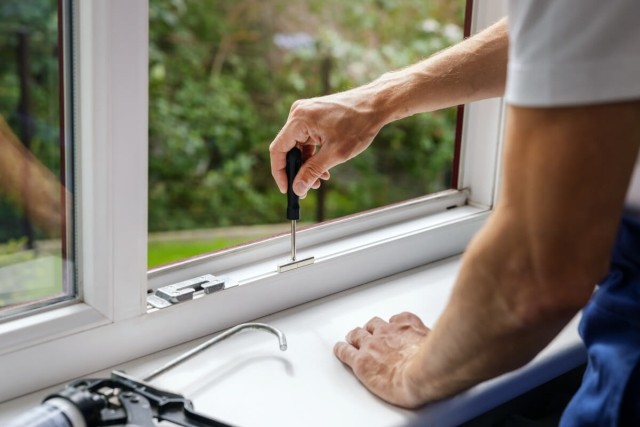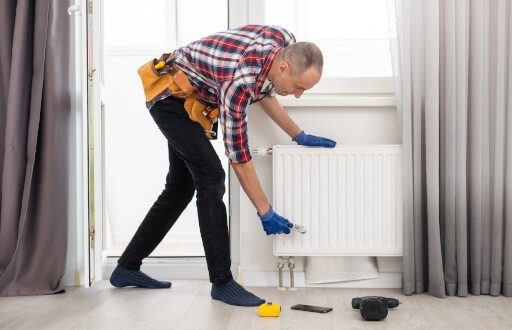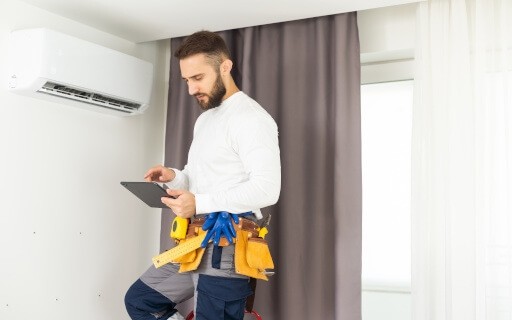Depending on where you live, some part of the HVAC acronym no doubt applies to you and your rental property. HVAC refers to heating, ventilation, and air conditioning — all separate systems that make up the climate of your home, and they have to be in proper working order for your tenants.
It’s important to stay on top of your HVAC maintenance, not only for your tenants’ sake, but because keeping your heat and air conditioning systems in tip-top shape will ensure a longer lasting unit and a more comfortable rental.
Is Heat Required in a Rental?
This is the “H” in HVAC, and the short answer is yes. In all states, adequate heating is required for a home to be considered habitable. Many communities (mainly cold-weather cities) get extremely specific about heating requirements. For example, New York City requires heating units to maintain a minimum temperature of 55 degrees Fahrenheit from October 31 to May 31, and San Francisco requires a minimum temperature of 68 degrees between the hours of 5 AM to 11 AM and from 3 PM to 10 PM all year. Maine requires a minimum indoor temperature of 68 degrees when the outside temperature falls below 20 degrees.
It’s important to be familiar with requirements established by your state as well as your community.
What Does the “V” in HVAC Stand For?
The “V” or “ventilation” in HVAC is just as crucial as “H” and “AC.” Adequate ventilation means the air in your home won’t get stale, leading to that tell-tale musty odor of an older home. Central heating and cooling systems provide automatic air circulation, but rentals that rely on room heaters and lack air circulation systems may suffer the effects of stale air. These include a damp feeling home, pest infestations, and mold.
Ceiling fans are a crucial part of home ventilation, but they’re not commonplace in all states. Ceiling fans and portable fans can provide the circulation needed to control moisture and keep your tenants comfortable. You’ll also need to maintain them unless otherwise specified in the lease agreement.
Is AC Required in a Rental?
Air conditioning is of course the “AC” in HVAC. While some form of heat is required in all states, the same can’t be said for air conditioning. California requires heat, but it does not require air conditioning. The same goes for New York. However, local laws may contradict states laws, and you’ll know this if you grew up in the South. Georgia does not require air conditioning by law, but many cities do, and it’s become commonplace to have AC in most rentals.
If you do rent a unit with air conditioning, though, there’s a contractual responsibility for you to maintain it. If you don’t, your tenant may be entitled to a rent reduction or some other consideration like ceiling fans or another form of ventilation.
The Two Most Common HVAC Maintenance Issues
Now that we’ve discussed the systems covered under “HVAC,” let’s cover some of the most common maintenance issues that you will experience. Having a general understanding of what can go wrong with your HVAC system could make it easier to avoid big problems in the future. Renting to tenants who know what to look for and what to maintain could also save you (and them) a few dollars too.
Common Thermostat Issues
Blowers, burners, heating elements, and refrigeration coils can all malfunction, and when they do, the landlord has to repair or replace them. Many HVAC problems, however, result from the thermostat, which can easily be maintained by tenants.
Programming
Failure to program the thermostat properly is such a common occurrence that many appliance repair specialists address it first. Is the thermostat switch properly selected for heating or cooling? Is the target temperature properly selected? Is the unit even on? Tenants should have a copy of the manual so they can check the settings themselves before calling for help.
Batteries
If the batteries in the thermostat are weak, the heating/cooling system won’t get the message to turn on. Batteries are easy to replace, and the tenants can do that themselves, especially if they have the manual.
Cleaning
Thermostat leads can get dusty, and all it takes is a blast of compressed air to clean them. Accessing the leads means removing the cover, which tenants can do if they have the manual to guide them.
Location
Persistent failure of the central air system to maintain the target temperature could be caused by a poor thermostat location. It may be in the sun, behind a bookshelf, or in the path of a draft. Moving the thermostat, as well as replacing worn wires, is usually a major job.
Change Your Filters Frequently
Your HVAC system connects to the living space of your house via a network of either metal or plastic ducts. Where the air comes into your home is called a supply vent, and where the air is pulled into your heating and cooling system is the return vent. When dust and other debris enters the ducts and gets drawn into the system, it can block heating elements, slow fan rotation, reduce the overall efficiency of the system, and even potentially create a fire hazard. That’s why it’s important to change the filters located in your return vents. Every three months or so is the general rule of thumb for wall or ceiling-mounted returns, but every month is better if your home has floor-mounted return vents.
Filters are classified according to their MERV rating, which is an acronym that means Minimum Efficiency Reporting Value. The higher the MERV rating, the better the filter is at trapping certain particles.
Filters with high MERV ratings can filter out contaminants as small as bacteria, but they also restrict air flow, so it’s best to stick with a filter with a rating in the range of 5 to 8, especially if you have an older HVAC system.
Who Is Responsible for HVAC Maintenance?
Like most aspects of a rental property, it’s up to you, the landlord, to maintain the HVAC system in your rental as long as the instances of maintenance weren’t caused by tenant neglect. However, the tenant also has an interest in keeping things in working order. It will probably be easiest to assume all responsibility yourself, but if you live far away from your property, you could assume joint responsibility with your tenant to make your life easier.
Landlord Controlled and Maintained
This is the most common way to approach HVAC maintenance. The lease usually specifies standard hours for maintenance, such as from 8:00 a.m. to 6:00 p.m. Monday to Friday. If maintenance is required at other times, there is usually an extra charge. You’ll typically find this in rentals with multiple units.
Keeping Track of Maintenance Issues
As a landlord it's essential to keep track of any maintenance you preform, especially for an HVAC. Luckily you can easily keep track of any maintenance with Apartments.com. With our online maintenance platform, tenants can submit maintenance requests online. We notify you when you have a request, and you can easily update your tenants as the repair progresses. You can even attach receipts, upload notes, and track expenses for the repairs. You and your tenants can even share images and videos. Keeping everything in one place makes it easy to keep track of repairs, how often something is requiring repair, and how future repairs might impact your budget.
Landlord Controlled/Tenant Maintained
The tenant pays for filters and minor service calls, such as cleaning and minor malfunctions, while you pay for major service. This can be a good arrangement for sensitive tenants who require enhanced air filtration or who require temperatures outside the typical range.
HVAC problems can be some of the most daunting and expensive issues to deal with in your rental. Hopefully, by understanding your HVAC system and finding a maintenance solution that works for you, you can keep your property and tenants comfortable and avoid big bills at the same time.











